1981 Italian Grand Prix race report
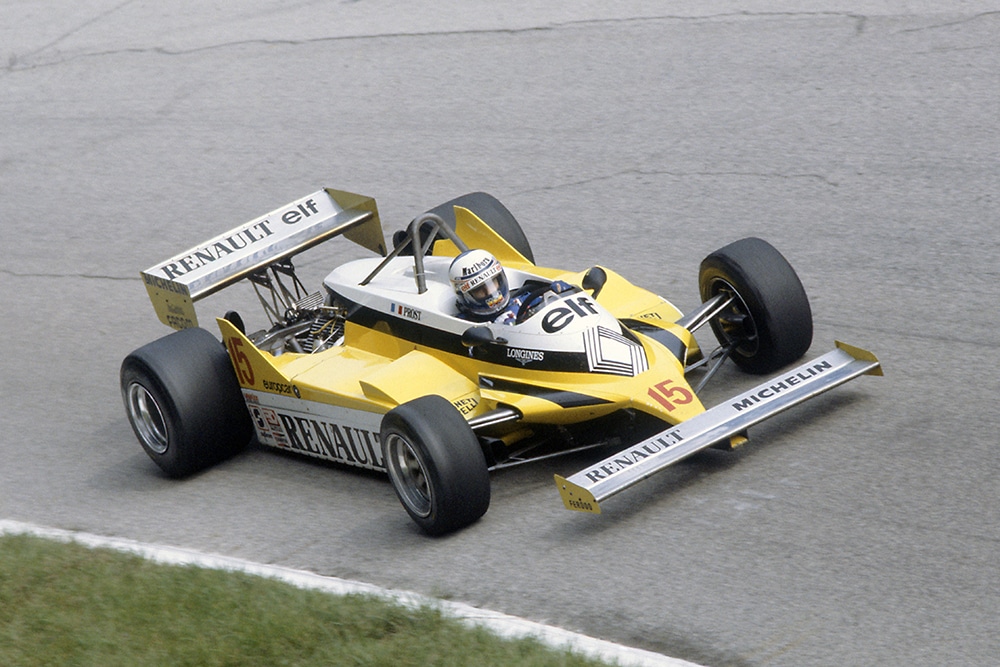
Renault's Alain Prost made it two wins in a row at Monza
Motorsport Images
Renault all the way
Monza, Italy, September 13th
In these rather unsettled days it was nice to get back to the Monza track, the true home of the Italian Grand Prix. It looks as though common sense is going to prevail over big business and the Italian Grand Prix is to stay at the Monza track, while the San Marino Grand Prix will be run at the new, and very satisfactory, Imola track. There were no great changes for this event, everything being much as it was in Zandvoort at the Dutch Grand Prix, though the Osella team arrived with a brand new design, the FA1C, on which everything was newly designed by George Valentini whose experience goes back through the Abarth days to those of Gigi Plate, Jean-Pierre Jarier had tested it briefly at the private Ferrari test-track at Fiorano but it needed finishing off, with things like rear-view mirrors, on the first morning of practice. While being conventional in its conception it was a much neater and tidier looking car than the previous Osellas.
Of the much publicised Alfa Romeo V8 turbo-charged car with carbon-fibre monocoque there was no sign, not even a photograph, while of the other near-mythical turbo-charged car, the Brabham-BMW, there was equally no sign. In the Lotus camp the lads were up all night finishing off a brand new Lotus 87, number 5 in the series, and Talbot-Matra had a brand new JS17 for Laffite, but like Alfa Romeo this new French car seemed to be devoid of identification. Andretti had what appeared to be a brand new Alfa Romeo, unchanged in design but tidied up here and there, and certainly very clean. Most of the other teams had their regular cars, the ravages of Zandvoort having been cleaned off, but Ferrari took a backward step by bringing out 053 (Villeneuve) and 054 (Pironi) with the original monocoque and front end, but the latest type of rear end. They had two spare cars, 052 as the previous two cars, and 049/B with the latest modifications front and back.
Qualifying
Apart from one or two minor sponsors changing teams or spreading their largesse in other directions, and the arrival of one or two for a one-race deal in advertising, everything was in pretty good shape on Friday morning when testing began. It did not stay that way for long as Andrea de Cesaris crashed his McLaren MP4 and someone estimated that it was his nineteenth crash this season! The weather was heavy and sultry, as was the atmosphere in the McLaren team and they did not rush to repair it for the afternoon’s qualifying session. In fact, there were deep mutterings about putting de Cesaris out to grass and calling it a day. The qualifying hour had just got under way when everything stopped as Pironi had gone off into the barriers in a very big way at the second Lesmo corner. Everything had seemed to be going perfectly for him, the speed felt right, the handling felt right and suddenly the front slid away and the whole of the left side of the Ferrari 126CK/054 was wiped off on the barriers. Pironi was unharmed and returned to the pits to say he had no idea what had happened. Quite unmoved he got into his T-car (049/B) and proceeded to go even faster. Meanwhile Piquet was putting in his times in the spare Brabham with the carbon-fibre brake discs, and Reutemann was taking his time about going out and using up his two sets of tyres. In the morning Rebaque’s engine had broken and he was now waiting for the car to be finished off, after having the engine replaced. For the first time this year, in spite of an obvious Concorde Agreement rule, the Brabham cars had the drivers’ names written on them clearly, and Rebaque had his name on the T-car as well as his own, but did not use it. While Piquet was driving it,the Mexican’s name was taped over.
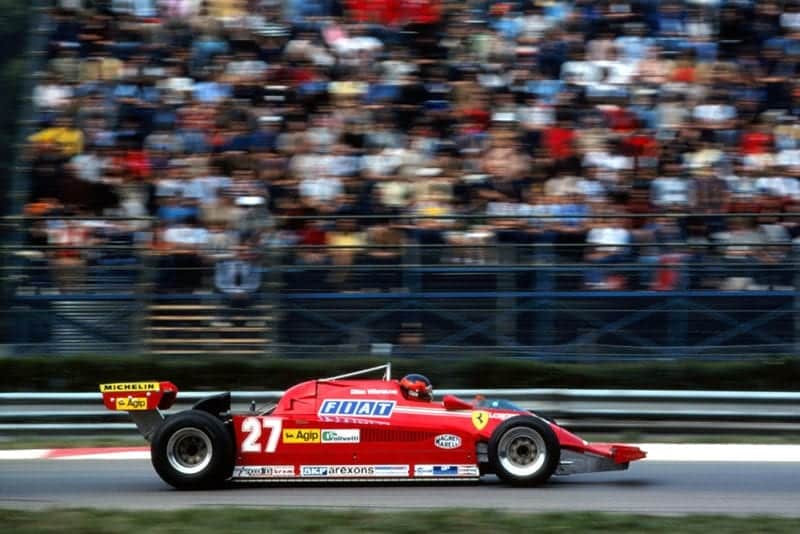
Gilles Villeneuve qualified 9th for Ferrari in front of a partisan home crowd
Motorsport Images
The new Osella was giving a few problems of a “teething” nature, and Enzo Osella himself was helping the mechanics to bleed the brakes. Brian Henton had been going well in the morning test-session with number 5 Toleman-Hart, using the single-casting head-block-crankcase Hart engine, and looked a cert for qualifying within the chosen twenty-four, but a failure in the inter-cooler system forced him to transfer to the older spare car. As is becoming familiar these days the qualifying hour lacked any sort of animation and it was no great surprise to find the two Renault drivers had done their job well and were first and second by “a country mile” being in a class of their own in the 1 min 34 sec bracket, while a very confident Reutemann was “best of the rest”. His team-mate, World Champion Alan Jones, was nursing a broken finger and some bruises and abrasions as a result of a public brawl in West London over a difference of opinion on driving manners in traffic. A look down the list of times made an eyebrow or two rise when it was seen that Alboreto on Avon tyres was faster than Cheever on Goodyear tyres, both in 1981 Tyrrell cars. Not only did eyebrows rise in the Talbot camp when it was seen that Tambay was faster than Laffite, but the team management (Laffite!) decided they would swap cars for Saturday’s practice.
On Saturday there was still no sign of Sunny Italy and the sky was very overcast, but at least the rain kept off and it was warm. To many people’s surprise the McLaren team repaired MP4/1 and de Cesaris was let out again and to his credit he covered 22 laps without an accident. Watson was soon forced to take over his T-car (MP4/2) as his race car (MP4/3) sprang a leak of oil which necessitated removing all the underside of the car to get at it. In the pre-race blurb from Marlboro there was a great explanation about new megaphone exhaust pipes on the Alfa Romeo V12 of Andretti, which were said to give 15 bhp more and improve the pick-up from corners. During the morning Andretti ran with the megaphones, then stopped and had a set of thin parallel pipes fitted in their place and tried again and that was the last we saw of the “trombones”. In the Ferrari pits the Brembo brake men were giving a lot of attention to the brakes on Villeneuve’s car, though the Ferodo brake pad lining man was very happy with the temperature situation. Pironi was still in his T-car, his crashed one being beyond immediate repair, but he was in trouble with a failed turbo-charger bearing. Considering that the KKK turbine/compressor unit is revolving at close on 100,000 rpm, and 90,000 rpm is quite normal, the plain sleeve bearings on which the shafts run need some very drastic lubrication to get rid of the heat. At the bottom end of the pits the Theodore team were in trouble as their number one car died out on the circuit with ignition trouble, so Surer was having to use the spare car to decide on tyres and aerodynamic settings in readiness for the final qualifying hour in the afternoon.
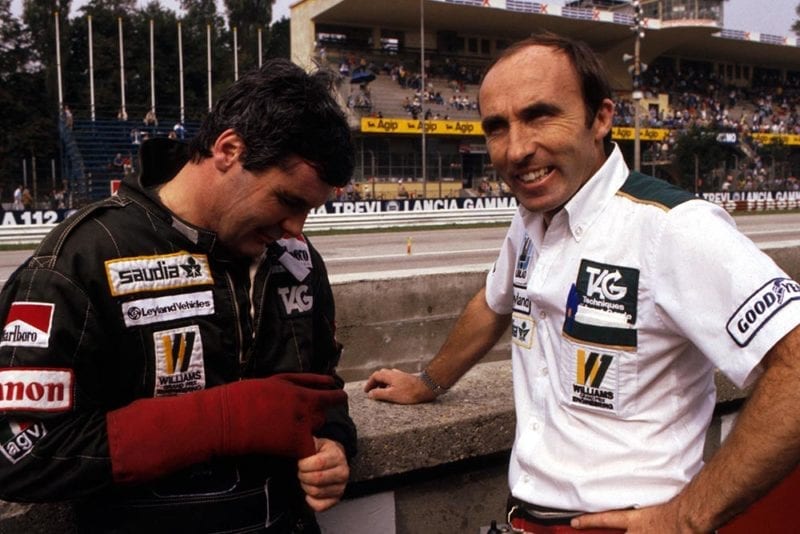
Alan Jones chats to Williams team principal Frank Williams
Motorsport Images
During the lunch-break (hard-work time for the mechanics and team personnel) the weather improved slightly and began to get warm, though the air was hazy. After the total domination by the Renaults on Friday and the poor showing by Ferrari and Alfa Romeo (Villeneuve fifth, Pironi seventh and Andretti 13th) the crowd on Saturday was very poor and very quiet. Gone was the sight of the main grandstand (free on Saturday) full to overflowing, with screams and cheers every times Ferrari left the pits. The scene was very subdued and almost dull.
Such is the slow pace of qualifying these days that seven minutes after the session started de Angelis was still preparing to go out, and Colin Chapman was not in a frenzy! This time last year they would have already got through two sets of qualifying tyres and the Goodyear depot mould have been hard at work to keep everyone supplied. Andretti’s Alfa was still running on straight exhaust tail pipes and Piquet was in his spare Brabham. The Theodore team had cured the ignition fault on their number one car and we had not been going long before Watson stopped out on the circuit with an electrical failure. He got back to the pits on foot and went out in the T-car. In the Ferrari pits there was a certain amount of tension, for Pironi in his T-car (049/B) came in saying the engine was vibrating badly and then went off in Villeneuve’s T-car (052), whereupon the French-Canadian arrived in a cloud of smoke from a ruined turbocharger only to find he had not got a spare car any morel He had to sit-out the rest of the qualifying time and watch Pironi trying to push him down the grid, which he finally managed to do. In the Williams camp Reutemann was in devastating form and had the Renaults on the run, eventually getting between them, though it must be admitted that Prost was thwarted by having a slight “moment” when overtaking de Cesaris, which resulted in the Renault bending a nose fin and damaging a wheel. Apart from the pain and inconvenience of the bandaged finger on his right hand, which hampered gear-changing, Jones was in further trouble when his engine blew up and he could not get back from the far end of the circuit, to go out in his spare car. Like Villeneuve he had only used one of his sets of tyres, so we had the unusual situation of two drivers with tyres to spare. Giacomelli was in great fighting form and not only was he ahead of his team-leader, but he was also the fastest driver, which sounded good until you realised there were nine “foreigners” in front of him, from France, Argentina, Australia, Brazil, Canada and Ulster.
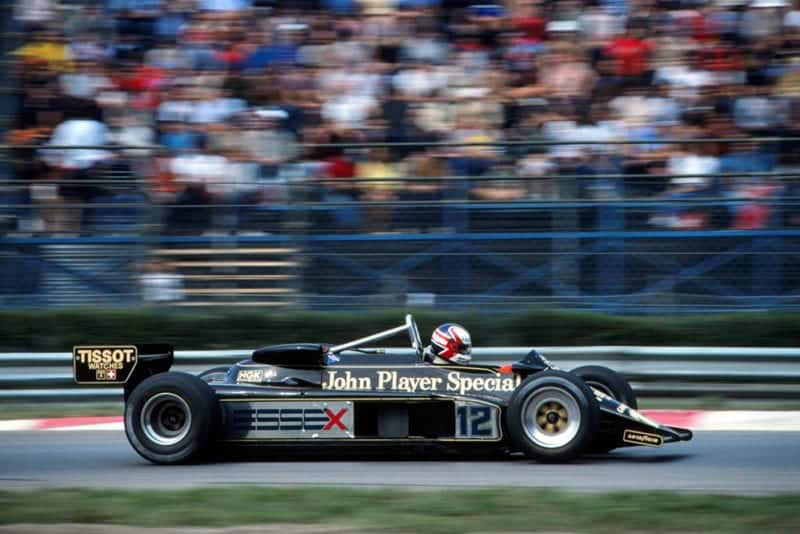
Nigel Mansell retired in his Lotus 87 with handling difficulties after full fuel tanks were responsible for wearing away the cars skirts.
Motorsport Images
The first six on the grid were separated by two seconds, but the last six on the grid had only 1.3 sec separating them, and it’s supposed to be tough at the top! At long last one of the Toleman-Hart cars had scraped on to the grid, in twenty-third place, just ahead of Salazar in the Ensign. It was fitting that it was Brian Henton who made it as his enthusiasm has never wavered, even when the team has been in the depths of despair. Everyone in the team now realised that the real work now began — qualifying for a race was the easy part! The six drivers who failed to qualify were covered by 2.3 sec and these were Surer (Theodore), Gabbiani (Osella), Warwick (Toleman-Hart), Stohr (Arrows), Rosberg (Fittipaldi) and Serra (Fittipaldi). In the closing minutes of qualifying Piquet disappeared off the track in a cloud of dust with what seemed to be a punctured right rear tyre, but later investigation showed that a stone had gone down the brake cooling duct, split the caliper and sliced into the wheel rim. Damage was minimal and it became apparent to everyone that Monza in 1981 was remarkably safe.
Race
As everyone started preparing for race day there was a rather sour note down at the back of the grid when someone in the Theodore team put in a protest that Henton’s Tolernan-Hart did not have its skirts fixed according to the letter of the law, even though the scrutineers had passed the car. The protest was thrown out but a lot of people took a poor view of the action, remembering that Toleman withdrew one of the cars from practice in the Belgian Grand Prix to allow the Theodore to take part, purely in a gesture of goodwill. It was interesting that many of the teams and people that really matter in Grand Prix racing visited the Toleman pit to offer congratulations on them finally getting a car into the race. With a totally new and totally self-contained team, starting everything from scratch at the beginning of the season it had been a long, hard slog for them and lots of people were very appreciative of what it has meant.
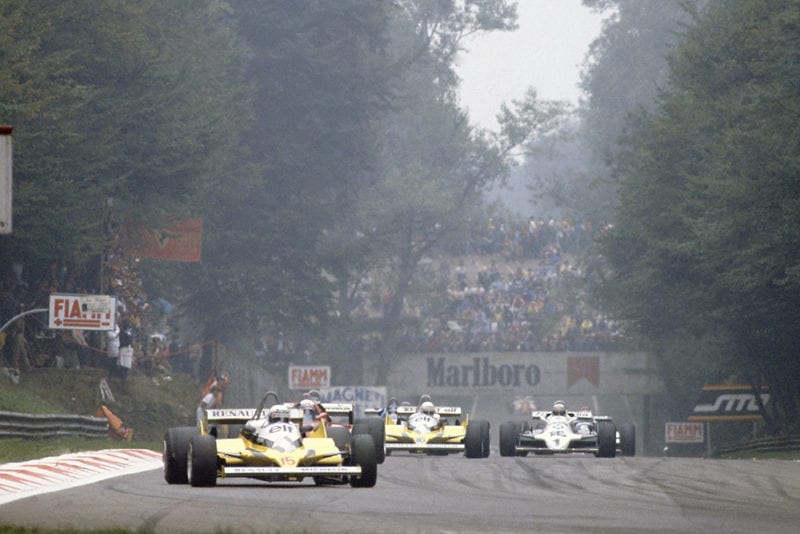
Prost took the lead from team-mate Arnoux on lap 1
Motorsport Images
On Sunday morning the Italian skies were grey and while a goodly crowd filled the Autodromo it was nothing like it would have been had Ferrari or Alfa Romeo been on the front row. The half-hour warm-up did not take place until after midday, as the race was not due to start until 3.30 pm. Pironi was back in his own T-car (049/B), but 052 was prepared with both drivers’ names on it. When Pironi came into the pits after a few minutes with a piston failed there was no delay, the car was whisked away for an engine change and the spare car remained with Villeneuve’s number on it. Andretti’s Alfa was showing signs of misfiring and the electrical system was being fiddled with and the Toleman team were a bit worried because a misfire crept in after a few laps running. They were far more worried when Henton failed to reappear at the end of the half-hour, fearing the worst. The car was towed in at the end of the warm-up session and Henton explained that in his excitement he had locked up the brakes at one comer and slid off into the sand, but all was well. Reutemann had decided to race without nose fins, in the interests of reducing drag, but Jones decided to keep his on as it made the car easier to steer into corners and he wanted all the help he could get to overcome his damaged right hand. The March team had made a litttle progress with their aerodynamic experiments and were happy to let Daly run without nose fins. The new Osella was quite good for a first time out, and had qualified easily, but needed better adhesion at low speeds, but the Renault team were quiet and confident, even though Reutemann was between them on the line-up.
With very little warning or ceremony the cars left the pit lane on their lap round to the starting-grid, so that there was none of the usual feverish excitement in the packed grandstands. In fact, you could feel that everyone knew that Ferrari did not stand much hope of success in this Italian Grand Prix, and they were all showing it. As the cars lined up on the grid they disappeared under a shower of well-wishers, hangers-on and publicity people, while long-suffering mechanics tried to make any final checks that were needed. Jones was having his brakes bled. As 3.30 pm approached Arnoux, who was on pole position, was given the green flag to set off on the parade lap. When he reappeared out of the Parabolica curve the tail of the field could be heard going down the back straight, for the three artificial ess-bends introduced into the circuit in recent years had really spread the field out. It was actually Reutemann who was first back to the grid, strictly against the rules, for Arnoux was being very intelligent and creeping slowly towards the grid with an eye on the mirror waiting for the tail of the field to catch up. Had he sped straight up to the grid he would have had to sit there for an unnecessarily long while waiting for the rest to arrive. Twenty three cars were lined up tidily, for Alboreto had disappeared into the pit lane, heading for the Tyrrell pit. Whether it is a product of the Renault turbo-charged engine, the Michelin tyres, the Renault chassis or the Renault drivers, or a combination of them all I do not know, but the two French cars shot off the line when the green light came on, whereas Reutemann was the first to move but then hung back with spinning wheels, but Pironi was away in the sort of start that Villeneuve usually makes. Only twenty two cars left the grid to start the 52 lap race, for Rebaque’s Brabham died on him and it was wheeled across to the pit lane for attention.
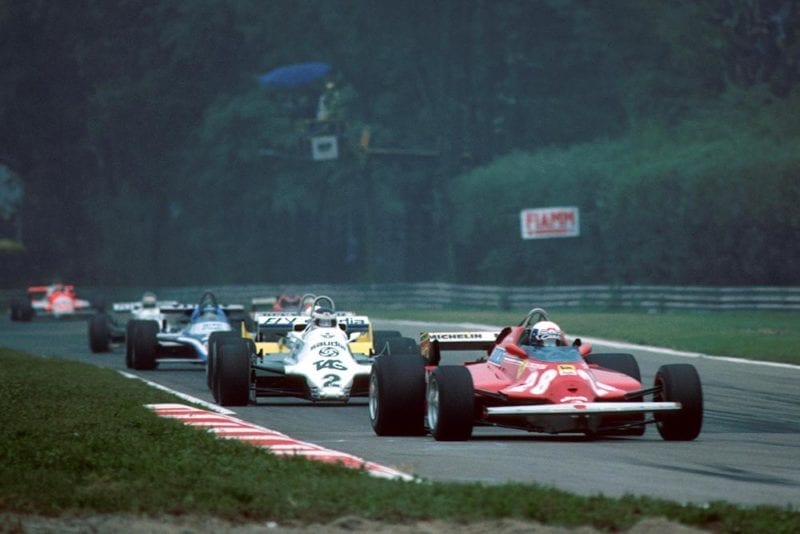
Didier Pironi leads Carlos Reuteman during the mid-race battle
Motorsport Images
By the noise and excitement it was obvious that a Ferrari was doing well, and sure enough it was Pironi in second place behind Prost at the end of the opening lap, followed by Reutemann, Arnoux, Jones and Laffite. Then came Villeneuve, Piquet, Giacomelli and the rest, with Henton and Cheever bringing up the rear. Already by the second lap Prost was pulling away, but the cheers were still for Pironi who was holding on to second place, and when they had all gone by Alboreto and Rebaque left the pit lane to start their race. The Brabham sounded awful and sure enough expired half-way round the lap, while Alboreto settled down to a lonely race. As far as Prost was concerned it was all over by lap 3, he was just motoring away into the middle distance and Arnoux was gathering himself up to join him. He passed Reutemann on lap 4 and Pironi on lap 5 and had left them all behind by lap 6. On this lap Villeneuve trailed into the pits with smoke pouring from one of thc exhaust pipes and his race was run.
Close, bunched, slip-streaming battles are a thing of the past at Monza unfortunately, thanks to the likes of Jackie Stewart and his cohorts in the past, so the field of twenty-two cars was now pretty well spread out. It was not so much a question of racing as seeing who could keep going and avoid any trouble or any unforeseen circumstances that might arise. Pironi’s initial spurt was now beginning to dissipate itself and Laffite moved up into third place, so we had French drivers and French cars from French manufacturers in the first three places, but it did not last as the Talbot-Matra was in tyre trouble and began to slow visibly so that Reutemann moved his Williams back into third place and Pironi moved briefly into fourth, but not for long as Jones and Piquet were moving up pretty steadily. Now a new factor appeared in the form of a light rain shower on the back leg of the circuit which made the back straight and the Parabolica curve slippery and Reutemann was finding he could not cope with the conditions like some of the others, due to having a diferent tyre choice on his car. Jones was up into third place as Laffite and Borgudd slid off on the slippery surface. On the next lap Cheever spun his Tyrrell on braking for the Parabolica and as his clutch operation had given up when he left the start, he could not avoid stalling the engine. Prost had already lapped him, and as Arnoux arrived he had to dodge to avoid the Tyrrell and the slippery surface caught him out and he slid off into the sand and out of the race. The rain spread across the corner of the circuit but did not cause any more problems, but on lap 14 Salazar had a big moment when a rear tyre went down on the Ensign in the fast Cotta Grande, after the pits, but it all came to rest without harm.
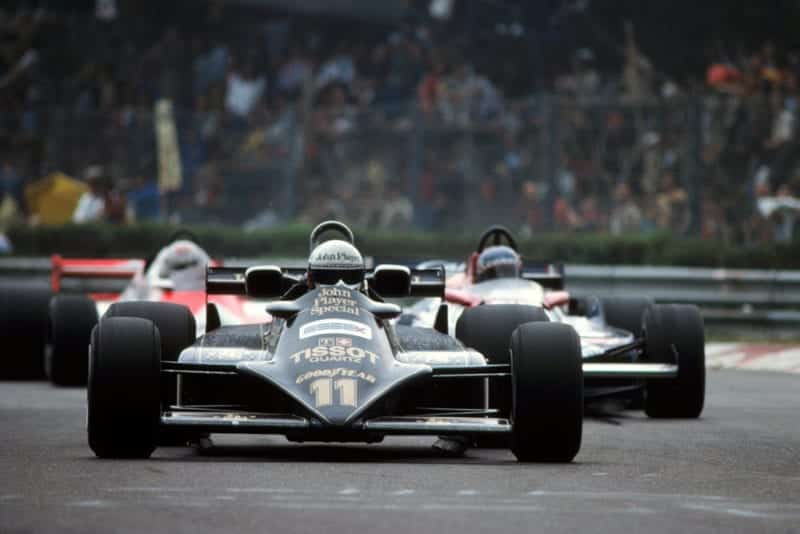
Elio di Angelis finished 4th at his home race
Motorsport Images
While others were being a bit cautious or sliding off the road on the slippery part of the circuit, Giacomelli was revelling in it and passed first Pironi and then Piquet, and when Reutemann dropped right back because of the slippery part, Giacomelli moved into third place, to cheers from the crowd. Prost was way ahead and looking very secure, while Jones was equally secure in second place, but in the wet Tambay had moved up dramatically, passing Watson, then passing Pironi and then passing Piquet, leaving the Brabham and the Ferrari locked in combat while the Talbot-Matra was in fourth place. From third place Reutemann had fallen right back to eighth place, later blaming his tyres vehemently. On lap 20 Watson was scratching to keep up with Piquet and Pironi, and leaving the second Lesmo corner he ran a bit wide out to the left, got two wheels over the edge and promptly spun. The McLaren went right round as it slid across the track and hit the right-hand guard rail backwards, whereupon the entire engine, gearbox and rear suspension was torn off the monocoque. There was an instant sheet of flame as the fuel pipes were torn off, then the automatic (mandatory) valves in the fuel lines snapped shut and the fire went out. The mechanical components slid across the track, causing Reutemann and Alboreto, who had been lapped, some anxious moments and the McLaren carbon-fibre monocoque slid to a stop with Watson more than somewhat dazed but entirely unhurt. All the kinetic energy had been absorbed by the engine/gearbox unit tearing itself off the monocoque and going on its way. If the monocoque had had to dissipate that amount energy Watson would have suffered badly. The near-miss put Alboreto off the road and delayed Reutemann, so that Andreiti went by him.
In that part of the race which involved those who were clearly not going to win, there were various interesting things going on. The black Guinness sponsored March of Derek Daly was going extremely well, and had avoided its usual early-race pit stop. From his position near the back of the grid he had caught and passed both team Lotus cars, and while de Angelis put up a fight and got back in front again, Mansell went into the pits to investigate some strange handling characteristics on his Lotus 87. This was on the lap on which Watson had his big prang, and after one more lap the Birmingham driver gave up as the car was undriveable. Although the Toleman-Hart had been lapped within twelve laps, it was still running and had not made a pit stop. Henton’s whole idea was to keep it going at all costs, no matter how slowly, for you never learn anything in the pits. The engine was plagued by a continual misfire at high rpm but Henton was learning to live with it.
On lap 23 Tambay’s valiant effort came to an end when his left rear Michelin disintegrated and he was off the track, and as he walked back to the pits from the north, Cheever was walking back from the south. As half-distance came up (26 laps) Prost was out of sight of everyone and simply cruising round, while Jones was firmly in second place. Poor Giacomelli saw his gallant third place go when his Alfa stuck in fifth gear and he headed into the pits for help. This left Piquet in third place, followed by Pironi, then after a fair gap, Andretti, Reutemann and de Cesaris, the Italian with the funny eyes actually keeping his car on the track this time. Behind the McLaren came de Angelis leading Daly, the Lotus driver beginning to drive with some enthusiasm and gain on the McLaren. Lapped by the leader were Jarier in the new Osella and Henton, and the unfortunate Giacomelli who rejoined when his gear selection had been sorted out. There was another brief shower of rain on the same part of the circuit, but it had no dramatic effect and Reutemann now began to speed up again and caught and passed Pironi, the Ferrari hampered by a damaged skirt caused by running over a kerb at one of the ess-bends. Daly’s good run came to an end on lap 38 when his gearbox final drive unit gave trouble, and Patrese had already quietly gone after an unimpressive performance in his Arrows A3 also with gearbox trouble. Pironi’s unbalanced handling was slowing him a lot and Andretti caught up with him, but before the Alfa could go by its flexible coupling-cum-shock absorber in the flywheel broke up and Andretti toured into the pits with an awful roughness going on behind him.
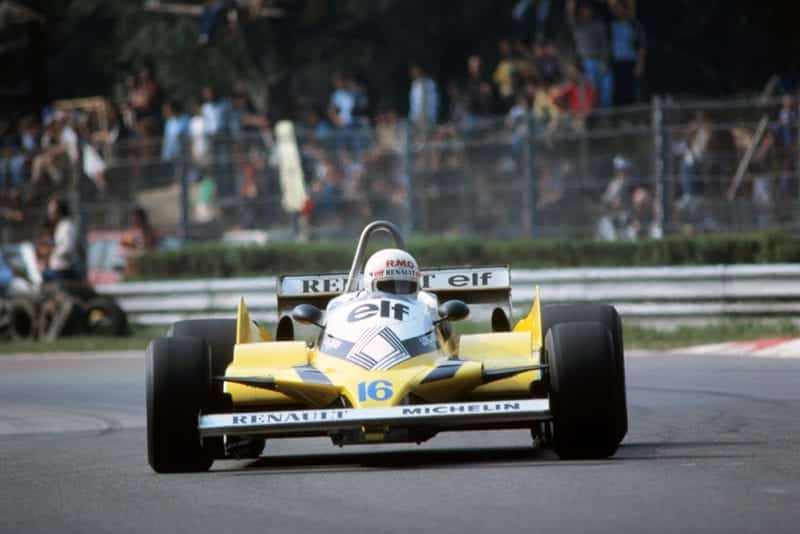
Rene Arnoux in his Renault RE30, retired after taking avoiding action when Eddie Cheever spun on a wet section of track.
Motorsport Images
As the laps ran out the Renault never missed a beat and Prost never put a wheel wrong, but Jones was slowing a bit with his engine going off song ever so slightly, but second place seemed confirmed. Piquet’s third place was not so sure, for Reutemann was back in his stride and closing rapidly, but Piquet speeded up, actually making his fastest lap when he was alerted to the danger. De Angelis passed the ailing Ferrari of Pironi on lap 44 and as Prost started his last lap it all seemed to be over, but half-way round the final lap Piquet’s engine blew up very suddenly, oil pouring out of the bottom and smoke out of the top and he coasted to a stop with half a lap to go to the chequered flag. This let Reutemann by into third place, giving Williams a 2-3 behind the Renault. and making sure of the manufacturers’ champiionship win. De Angellis came home fourth after a not very exciung race, and Piquet was fifth. In sixth place should have been de Cesaris in the McLaren, but on the last lap a tyre deflated and put him off the track, through no fault of his own this time. Because the remaining runners were two and more laps behind, Piquet and de Cesaris who only lost one lap by their misfortunes were classified sixth and seventh. Jarier had given the new Osella a non-stop run on its first appearence, and Henton had raised the spirits of the Tolman team by keeping their car going for the whole race without a visit to the pits. With a turbo-charged car at the front, and a turbocharged car at the back, and another in the middle of the ten finishers the future for 3-litre unsuperchaiged engines does not look good, but doubtless the ubiquitous Cosworth DFV will survive to fight another day, and if Keith Duckworth has anything to do with it the fight will be a good one, but it cannot be ignored that the Cosworth has failed to win the last three races. Austria to Matra, Holland and Italy to Renault. The scene may not be wildly exciting but it does not lack interest. DSJ.
Note: After the dust had settled and everyone had returned home, Alan Jones announced that he would be retiring at the end of the season.
